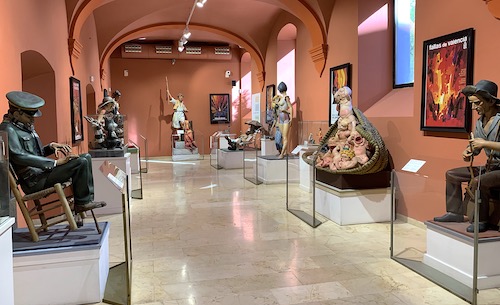Fallas Museum celebrates Spain’s fiery festival
By Jackie Sheckler Finch
Hours of painstaking labor go into creating beautiful works of art. Then the statues, called ninots, are set ablaze in gigantic bonfires.
Only one ninot is saved from the flames by the vote of celebrants. That lucky choice joins other reprieved ones at the Fallas Museum in Valencia, Spain. https://www.visitvalencia.com/en/what-to-do-valencia/valencian-culture/museum-in-valencia/fallas-museum
“It’s a tradition,” said museum coordinator Vicenta Expósito. “The ninots here are obtained by popular vote, which makes this museum unique in the world.”
To me, the whole Fallas (the fires) celebration is unique. It involves bands, pyrotechnics day and night, folkloric dances, parades, paella contests, pumpkin fritter and hot chocolate stands, crowning of the Fallas queen and her court and floral displays, plus about 800 fallas or sculptures. The lifelike statues are made of papier-mache, cardboard, wood or plaster and often depict bawdy, satirical scenes and current events.
This year’s festival, however, was cancelled due to COVID-19. But the popular Fallas Museum welcomes visitors who yearn for their annual fiesta. The 2020 cancellation is the first time the festival has been suspended since the end of Spain’s 1936-39 civil war. Celebrants are already planning for the 2021 Fallas on the customary dates of March 15-19.
“Those dates are important because they lead up to the feast day for St. Joseph on March 19,” Expósito said. “The ninots remain in place until March 19th, the day known as La Cremà (the burning).”
For La Cremà, young men use axes to chop holes in the statues and stuff them with fireworks. Streetlights are turned off and the ninots are set on fire at midnight. “Our firemen have become experts at making sure buildings are not accidentally set on fire by the fireworks,” Expósito said. “Fire-fighting equipment stands ready.”
History of Fallas
The origin of the Fallas is a bit unclear. Some say it started when carpenters of the city would clean out their workshops and burn leftover wood during spring cleaning. Carpenters also would burn the wooden stands used to hold the oil lamps they had needed to work during the darker time of the year. Since the festival is held during the season when days are longer and carpenters didn’t need oil lamp light to work, those stinky wooden instruments could be tossed into the fire.
St. Joseph – husband of Mary, the mother of Jesus – is the patron saint of carpenters and his feast day is March 19 which accounts for the burning. Other tales say Fallas is a ritual rooted in pagan times to celebrate the arrival of spring.
Whatever the origins of Fallas, it is recorded that the festival is hundreds of years old. The first written record is from the second half of the 18th century when the Valencian government made laws governing where the Fallas fires could be set.
With a population of about 800,000, Valencia more than doubles in size when revelers are drawn to the Fallas celebration. Several streets are shut off for the event and huge cranes can be seen moving the biggest ninots – some several stories tall – into the city’s parks, plazas and streets.
“Some of the ninots take a year to make,” Expósito said, adding that many of them appeal to a quirky sense of humor.
As if the final night were not enough noise and excitement, each day at 2 p.m. beginning March 1, a huge show of pyrotechnics shakes the air. Called the mascletà, the display is created each day by a different pyrotechnic company so each show sounds and looks different.
A tip from locals is to open your mouth to help with the pressure in your ear canal. That way, your whole body “feels” the mascletà pops. Quite an experience.
Choosing a favorite ninot
Then, like moths drawn to a flame, people walk around and admire the ninots. Of course, folks have to choose which ninot to spare from the fire. First done in 1934, the rescued ninots now have a lovely home at the Fallas Museum, located conveniently near the City of Arts and Sciences.
Opened in 1971, the historic building was once a leper hospital, inn, barracks, military prison and convent. The museum houses the collection of pardoned ninots along with Fallas posters since 1929, portraits of the queens in traditional Valencian costume, information on how the ninots are made and other memorabilia.
“The museum is the most visited municipal museum in Valencia,” Expósito said.
My favorite ninot in the museum is the 2014 statue of Miguel de Cervantes, creator of Don Quixote, first published in 1605. For the ninot, the Spanish writer is sitting at his desk using a quill pen to create his famous characters while tiny statues of the Man of La Mancha and his companion Sancho Panza gallop across the pages.
Although no one said it, to me Fallas carries an additional meaning. It celebrates the fleeting nature of life. We’re here. We’re gone. Just like those glorious ninots. Time marches on so enjoy each day, each festival that comes your way.
For more information on Valencia: Visit Valencia at https://www.visitvalencia.com/en
For general information on Spain: Contact the Tourist Office of Spain in Chicago at (312) 642-1992 or www.spain.info
Photos by Jackie Sheckler Finch
Photo cutlines:
1. The Fallas Museum has ninots saved from the Fallas burning since 1934.
2. Ninots often poke fun at some aspect of the world.
3. Music is an important part of the Fallas Festival.
4. A 1998 ninot of Jacques Cousteau with a baby penguin.















View Recent Comments